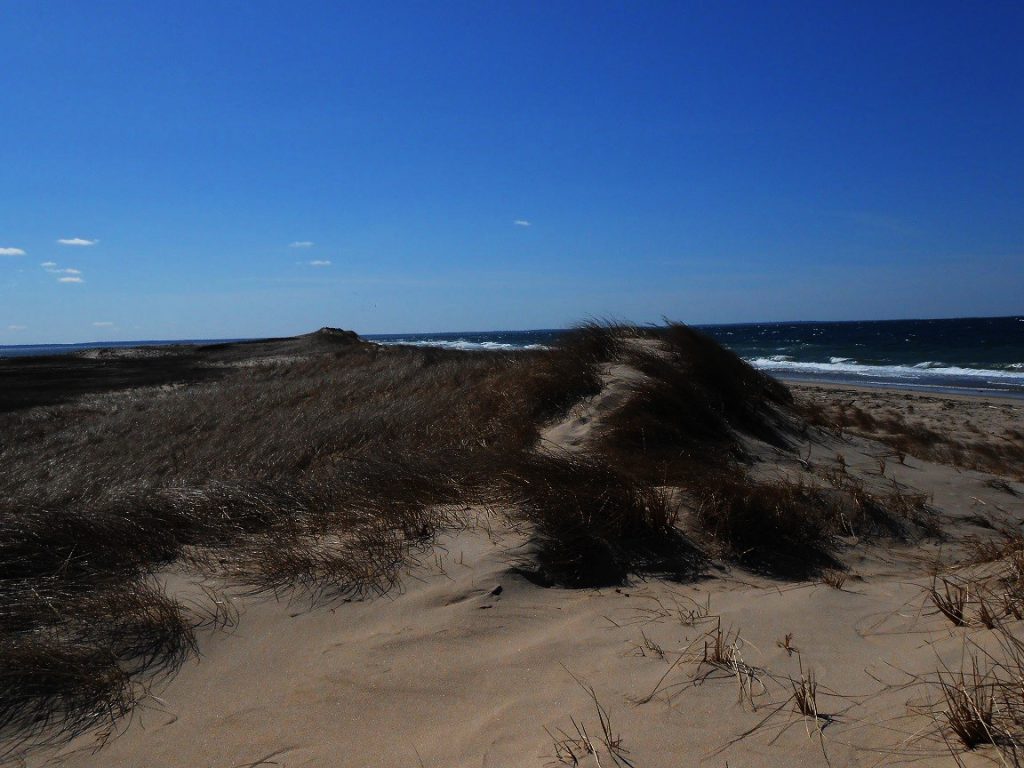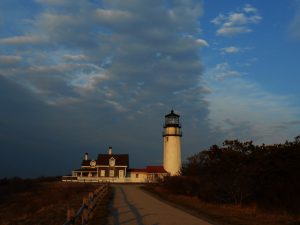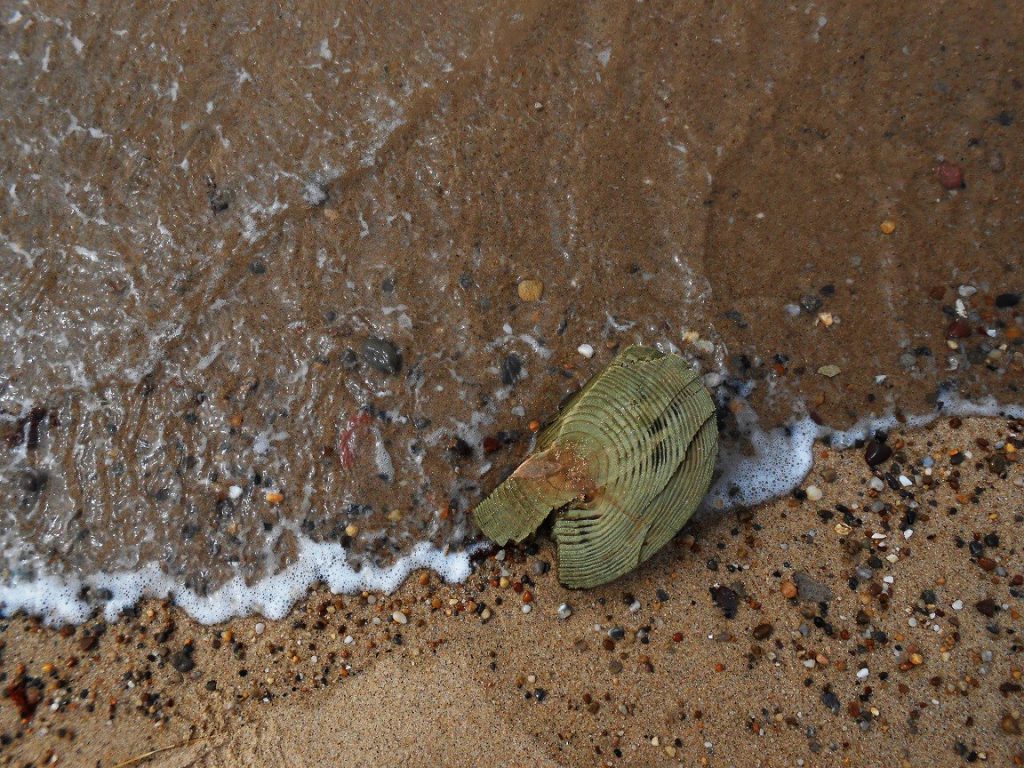
Cape Cod has been on my list of travel destinations for quite some time. What connects me to the Cape’s outermost beaches of Massachusetts are Henry David Thoreau’s walking activities between 1849 and 1857, which he published in his book Cape Cod. Another Cape Cod memory I cherish are the breathtaking paintings of the luminists Fitz Hugh Lane, Martin Johnson Heade, or John Frederick Kensett, some of whose works can be seen in the Boston Museum of Fine Arts. This March, I rented a small and cozy cottage in North Truro for almost a week, anticipating to finally substitute my mental and imaginary ruminations with actual walks along the beaches of the Cape. The second day, a snowstorm hit the coast so that in spite of the many layers of windproof clothing, I soon retreated to the warmth of the cottage, curled up in a comfy chair, and watched the snowflakes dance outside the windows.
Also, I began reading Henry Beston’s The Outermost House, a book published in 1928 and based on his yearly sojourn in his “Fo’castle,” a two-room cabin that he built for himself somewhere on the dunes of Eastham beach, a spot that has since succumbed to the onslaught of the waves. A classic of nature writing, The Outermost House from now on complemented my subsequent daily walks and beach experiences of the diverse sand- and dunescapes, inspiring me with its poetic language. It also sharpened my own observations of the birds and plants of Cape Cod as well as my experience of the ceaseless work performed on the Cape by the elements — the wind and the waves, the rain and the snow, the sun and the moon.

Beston opens his book with a condensed geological history of the Cape — linking it to a temporal and cosmological order beyond human time and reach — before zooming into its particulars of regional diversity. As I later found out, I had accidentally begun my explorations in the vicinity of his former two-room abode on the dunes next to the Eastham marsh. The fact that his cabin was swept away by a winter storm in February 1978, after it had already been moved inland, also acutely reminds me of the continuous alterations of the shape and size of the Cape brought about by the ongoing battle between the incoming waves and the out-pushing sand. As a thorough landlubber, I am quite ignorant of the change and course of the tides. Therefore it was by happenstance only that my hikes on the Great Island Trail and to the many northern and eastern lighthouses were undisturbed by the incoming high tide, even though the beaches had noticeably narrowed in breadth by the time I returned in the afternoons.
What delighted me probably as much as it did Beston in the 1920s were the varieties of the colors of the sandy dunes and beaches, ranging from “old ivory here, peat here, and here old ivory darkened and enriched with rust” (1–2). These variegated colors depend very much on the changes in tide, weather, atmosphere, and light. The day after the snowstorm was a glorious day which I spent walking the Great Island Trail at the western shores of Wellfleet Harbor. There, “a pool of the loveliest blue” (49) of the now clean-swept sky enhanced the beauty and intensity of the intermingling elements of water, sand, and wind. As I trudged along the trail’s marshes, I was taught a lesson about the different sounds of the gently lapping waves of the inland bay and the crashing and booming surf of the outer beaches.
However, the breakers that tumble onto the outer beaches of Great Island were tame compared to the powers of the massive breakers of the Atlantic Ocean. Beston describes these in his characteristically poetic manner as agents of their own:
Toppling over and hurled ahead, the wave crashes, its mass of glinting blue falling down in a confusion of seething, splendid white, the tumbling water rebounding from the sand to a height almost always a little above that of the original crest. Out of the wild, crumbling confusion born of the dissolution of the force and the last great shape, foamy fountains spurt, and ringlets of spray. The mass of water, still all furiously a‑churn and seething white, now rushes for the rim of the beach as it might for an inconceivable cataract (52–53).
Indeed, as the days passed, I began to envy Beston for the luxury of watching the surf for hours and experiencing the changes in weather, seasons, and tides.
My hike along the Great Island Trail ended with a pair of swans taking off from one of the small ponds in the marshes — a rare sight indeed! I also spotted several bald eagles, flying in groups of twos and threes. I could distinctly discern their white heads as they circled above my head, no doubt prying for some dinner in the moors that surround Race Point Road, which today is a concrete path for cyclists and walkers. In fact, the encounters with the animal life was astounding. Although it can in no way vie with the experiences of Beston’s patient and intimate observations of birds, eagles, otters, deer, and other animals, I very much enjoyed the singing of two pairs of northern cardinals in the trees just at the entrance of the cottage; and on my walk towards Race Point Light, I watched a pacific loon groom itself most thoroughly. While I tried to make the best of my amateurish little camera, the loon went about his business rather undisturbedly, managing to turn his behind to me whenever I took a picture. It was also on this walk that I saw quite a number of whales. It was a dark, rainy day, which made their spouts easy to spot, and as I was on my way towards the lighthouse, one whale came up so close that I could even see the shine of his black fin.
Beston does not write of whales. His focus is on his encounters with a wide variety of birds. These encounters are not all happy ones as they speak of a world of increasing human detachment and pollution, even environmental disaster:
George Nickerson of Nauset tells me that he saw an oil-covered eider trying to dive for food off Monomoy, and that the bird was unable to plunge. I am glad to be able to write that the situation is better than it was. Five years ago, the shores of Monomoy peninsula were strewn with hundreds, even thousands, of dead sea fowl, for the tankers pumped out slop as they were passing the shoals — into the very waters, indeed, on which the birds have lived since time began! (101).
Beston’s book generally involves an acute sense for the disregard of (American) society towards nature, its forces and inhabitants. Often contemplative and somber, there nevertheless runs through the book a sense of wonderment, joy, and fascination as well as a sense of companionship with the inhabitants of Cape Cod and even with the Cape itself. At times, his anecdotes include a subtle humor, for example, when he tells the story of the “lone coast guardsman” who “fell flat on a creature’s back, and it drew away from under him, flippering toward the sea, with a sound ‘halfway between a squeal and a bark’” (169–170). It was enough to startle me when I spotted the round-shaped head of a seal close to the beach on one of my daylight walks!
After Beston’s eulogies of the beautiful nights and night skies on Nauset Beach, I could not withstand the idea to also undertake some stargazing. One evening, after I thought it sufficiently dark, I ventured out onto the northern beaches dressed in manifold layers of windproof clothing in search of a promising spot. To my great disappointment, however, I found it rather difficult to get away from the lights of the lighthouses, and I eventually ended up lying on my back with my arms blocking out the lights.

The Highland Light, the lighthouse where Thoreau stayed during his sojourns on the Cape, was all deserted. So was the small museum by its side. I cycled up there one late afternoon when the rays of the sun illuminated it rather dramatically. Like the other lighthouses, it was moved considerably inland to save it from being submerged by the sea. I also found some “treasures” washed onto the beaches, such as the big piece of ancient wood which, as I also learned from Beston, must have come from the “ancient submerged forests which lie just off the present coast” (57). Indeed, to me the pebbles of the northern beaches that the sea gradually grinds into a rough sand were in itself a kind of treasure that I hope to re-visit someday — with or without Beston’s book in my luggage.

20,114 Total Views, 7 Views Today






